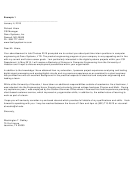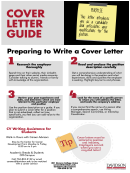Engineering Cover Letter Example
ADVERTISEMENT
COVER LETTER
GUIDE
Updated Jan 2015
A cover letter should accompany each résumé you send to a prospective employer when requested for full-time
employment. Cover letters are usually not required for internship opportunities but may be required to determine how
competitive your written communication skills might be. Your cover letter is your introduction; it describes who you are,
why you are interested in the position, and the value you can add to the organization. Do not duplicate your résumé in
your cover letter. Instead, use your cover letter to add a personal touch and highlight the most relevant experience within
your résumé, which tends to be more data-driven and should relate to the job description to which you are applying. The
following contain a few cover letter recommendations from employers who hire a large majority of UH students:
Language
Check the spelling and grammar several times, gaining feedback from career counselors, faculty, peers, and friends
and family members. Poor writing and grammar coupled with misspellings and typos within a cover letter can
eliminate the possibility of interviewing with a company; so be certain it is error-free.
Format
•
The cover letter should be brief, no longer than one page in length if sent via hard copy or via email.
•
Emailed applications should contain a cover letter in the body of the email with a résumé attached.
•
Typically, three to five short, easy-to-read paragraphs are adequate.
•
Keep your cover letter looking professional; use a standard font (i.e. Times New Roman, Arial, etc.), 10pt-12pt
font size only and avoid using bolded, italicized or underlined text. In special cases, such as when applying for
design/media/communications positions, students are encouraged to consider a more unique résumé aesthetic;
as a way to highlight their work.
Content
Always begin any professional letter with a date. If you have recruiter contact information, address your cover letter to
him or her using Ms. or Mr.; if you do not have recruiter contact information or full name, use, "Dear Recruiter”, or
“Dear Hiring Manager:"
Research the position and company as much as possible and tailor each cover letter toward the opportunity for which
you are applying. This might involve some time and effort but the information can usually be located in the job
description. Illustrate that you have the knowledge and skills necessary to fulfill the position requirements. It will show
that you have done your homework and assure the employer that you are a good match for the position. It will also
avoid the appearance that you have sent them a generic cover letter, which could have been sent to any company for
almost any position. If you are responding to an advertisement, make sure that you indicate where you viewed the
advertisement and within the body of your cover letter be certain to address at least 70%, if not all of the position
qualifications listed, to improve your chances for an interview.
NOTE 70% RULE: If you do not meet at least 70% of requirements in a specific job description, you are most likely
not qualified for the position. If you do, you are 70% or more likely to obtain the interview.
If you have developed a good networking relationship with an individual within the organization, upon obtaining his/her
verbal or written approval, use his/her name in your cover letter or as a reference.
Communicate that you can add value to the organization. Associate the company product with your capabilities. Avoid
making the common egocentric mistake of describing why the position would be good for you. Organizations are
interested in how your skills, abilities, and ideas will benefit their enterprise.
Let the cover letter reflect your individuality, but avoid appearing too familiar, arrogant, humorous or ironic. Describe
what is particularly appealing to you about this company and/or position. If you admire some of their recent work, a
current project or their philosophy of operation, let them know. Close the cover letter by taking the initiative and
requesting an interview. List your contact information for future follow-up.
ADVERTISEMENT
0 votes
Related Articles
Related forms
Related Categories
Parent category: Letters
 1
1 2
2 3
3 4
4








